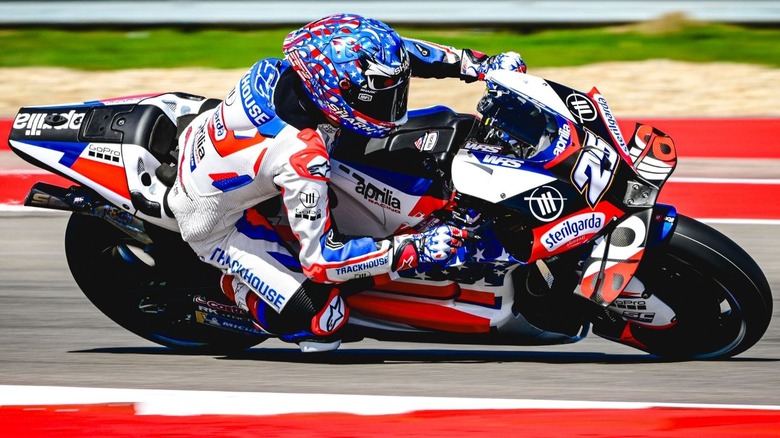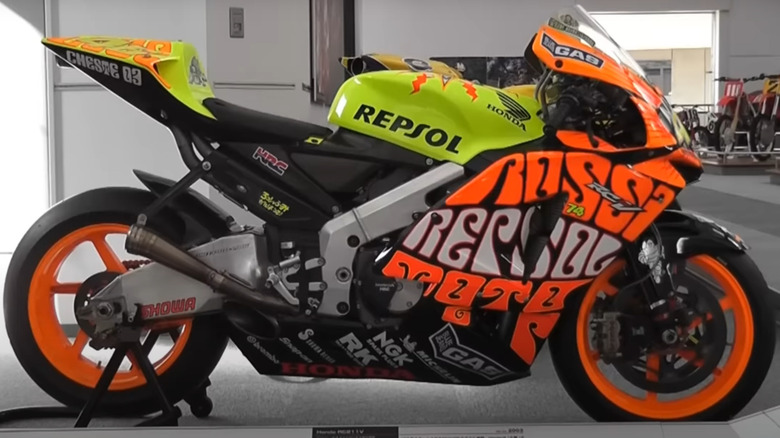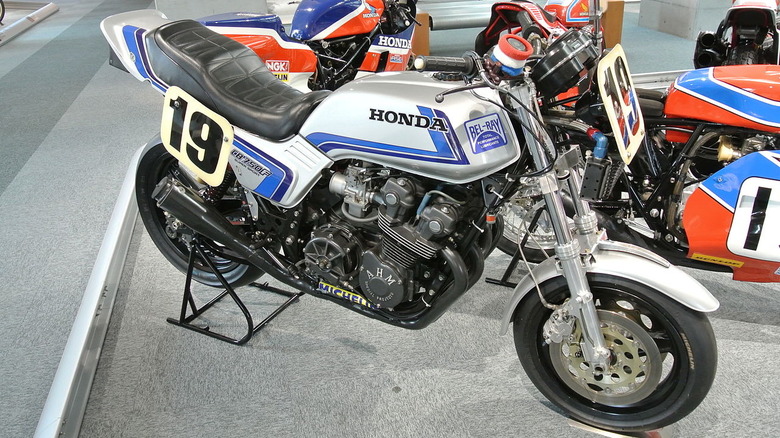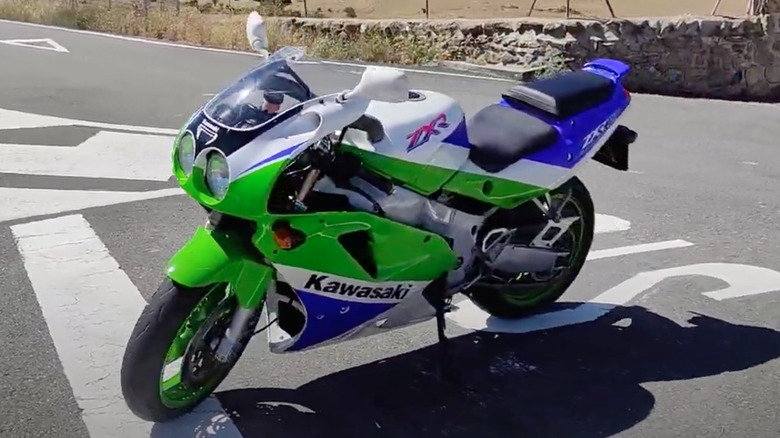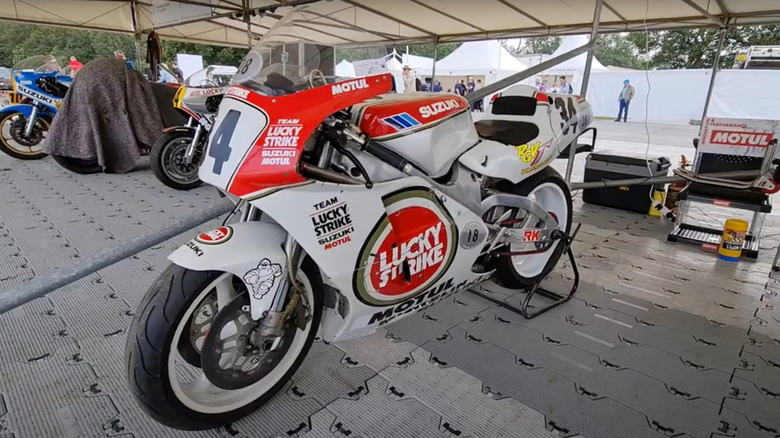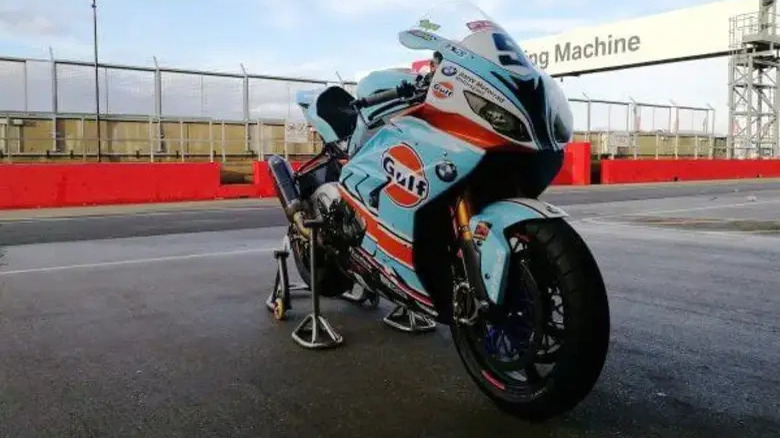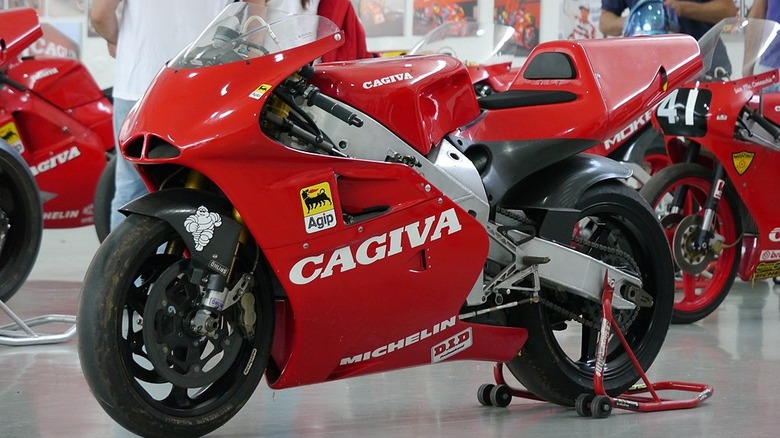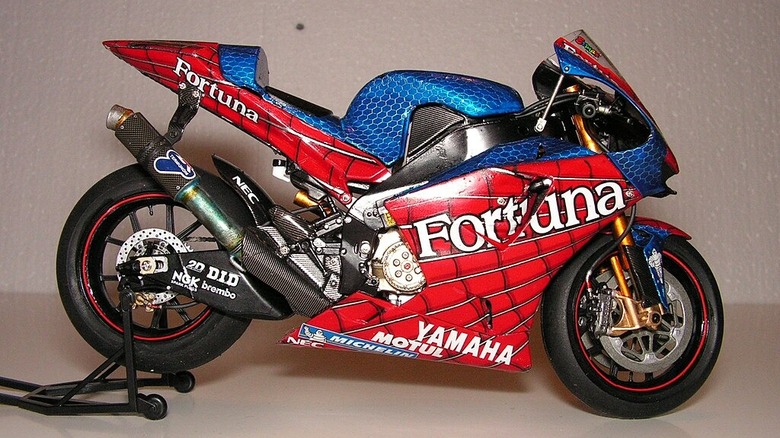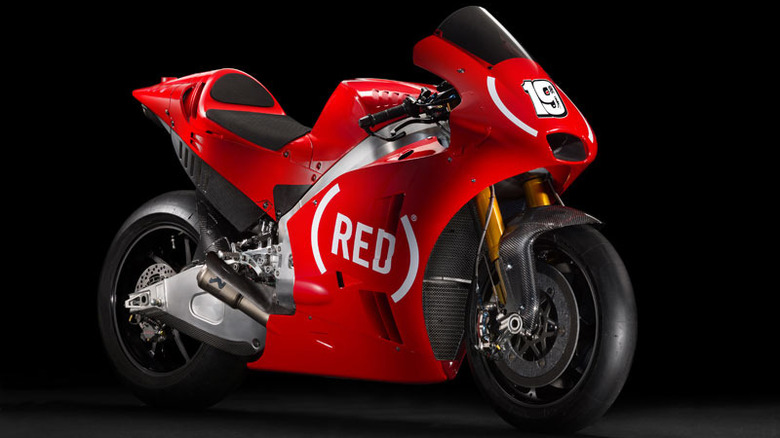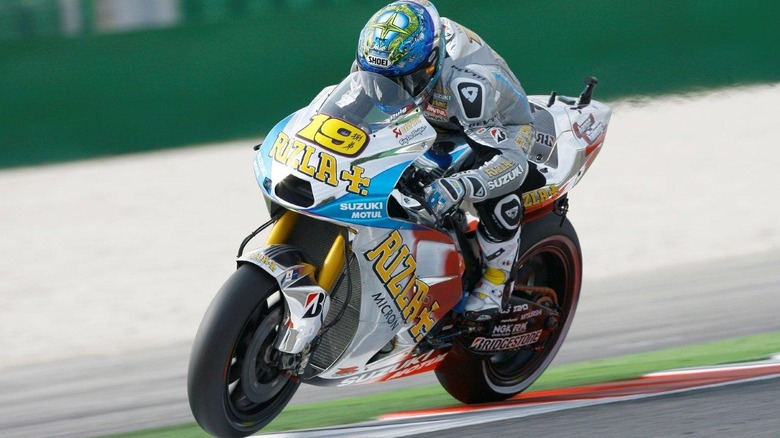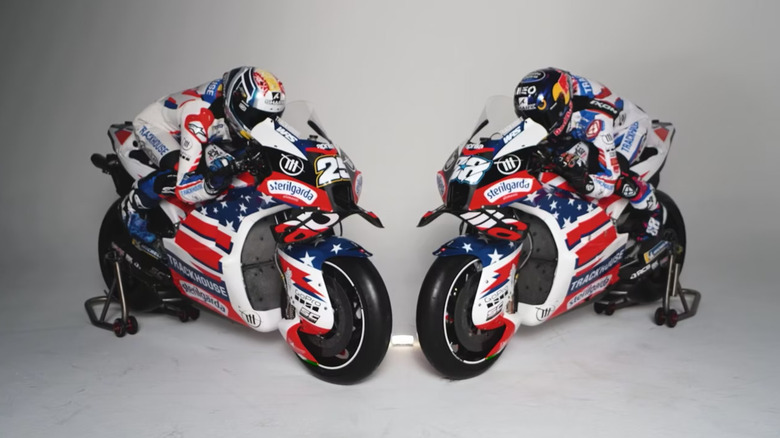10 Of The Coolest Motorcycle Decals And Liveries We've Ever Seen
Aesthetics are an important quality in the automotive industry, especially when it comes to high-performance vehicles. Motorcyclists, particularly sportbike riders, often seek eye-catching graphics and color schemes for their bike's fairings that might improve their visibility to other road users, give themselves a unique identity, or simply look cool. The word "livery" describes these, with roots in equestrian pursuits and military apparel. Still, nowadays, you are just as likely to hear it referring to vehicle decoration and motorsport sponsorship.
Liveries play a crucial role in motorcycle racing, especially in high-profile events like MotoGP and World SBK championships. Of course, sponsors use them to adorn their chosen teams with decals and colors depicting their logos and advertising their products. Yet, sometimes, these are one-off stylings to draw attention to a specific charitable cause, movie release, or sporting event, and sometimes, they are just for fun. Here are our picks of the most undeniably cool liveries to be seen on sport bikes and production motorcycles throughout history.
2003 Austin Powers Honda RC211V
Valentino Rossi is one of the most celebrated motorcycle racers of this century. Now retired, he has seven MotoGP championship titles to his name, with success in 250cc and 125cc classes and endurance racing. He started his MotoGP career with the Honda team, and it was in the last race of his last season with the Japanese giant that they decided to do something special before Rossi transferred to rivals Yamaha for 2004.
The European Motociclismo magazine held a competition to design the livery for Rossi's Honda RC211V for the upcoming race in Valencia. The winner was the Spaniard Ernesto Arnaez, who submitted a design as bold and charismatic as the movie character Austin Powers, who possibly inspired it. It included the sponsor's name, Spanish oil giant Repsol, along with the words "Rossi" and "MotoGP" in a groovy 1960s-style typeface.
Ernesto beat over 4,000 other contestants to win a Honda CBR600RR decorated with the same design. Perhaps more importantly, the "Austin Powers Honda" became one of the most memorable liveries of Rossi's career and a fitting tribute to his last race with the team, which he won, earning him his third consecutive MotoGP championship title.
1980 Honda CB750F AMA Superbike
The early 1980s AMA Superbike competitions mainly consisted of large, inline-four, bulky motorcycles with half-fairings, or, in the case of Freddie Spencer's 1980 Honda CB750F, no faring at all. Yet, despite, or perhaps because of, its lack of fiberglass paneling and logos, this bike exudes character and retro charm.
Honda's popular CB750 machine had already revolutionized the production motorcycle market as the "World's First Superbike." For the 1980 AMA Superbike season, it was given a major overhaul to meet competition standards. This included increasing its engine capacity to 1023cc and doubling its power output to 130 horsepower. Modified Goldwing forks were added, and the frame and steering geometry were altered to facilitate speeds of 150 miles per hour or more.
The Honda CB750F's silver and blue striped livery starkly contrasts the more elaborate graphics of its contemporary racing counterparts, but has come back into fashion on modern retro production models. It only takes a glance to tell that this bike is a product of the 1980s. Still, its livery's simple parallel lines and contrasting colors are timelessly cool and uncluttered, and it has inspired many imitations on sportbikes throughout the intervening decades.
[Featured image by Rainmaker47 via Wikimedia Commons | Cropped and scaled | CC BY-SA 3.0]
1991 Kawasaki ZXR750
By the 1990s, Japan's "big four" manufacturers, Honda, Yamaha, Suzuki, and Kawasaki, were well established across all motorcycle motorsports, traditionally favoring red, blue, yellow, and green livery, respectively. "Team Green" has always stood out on race day with its verdant color scheme, which continues across its wide range of production motorcycles.
From 1991 to 1996, Kawasaki produced a stunning line of ZXR750 models for the World Endurance and World Superbike Championships, ridden by racing legends Carl Fogarty and Scott Russell, among others. It was the decade that we started to see more artistic renderings in motorsport liveries, and the Japanese brand got it just right with a balance of tasteful primary colors and geometric lines. This carried over to its range of ZXR750 street bikes, which used the same diagonal lime green streak and angular design, switching between racing red and a cool blue around the seat, tank, and lower fairings.
The Kawasaki ZXR750 is likely best remembered in motorsports for "Mr. Daytona" Scott Russell's 1993 World Superbike Championship victory for Team Muzzy Kawasaki. Far from being consigned to history, the bike's graphic design lives on 40 years later and can be seen gracing the latest line of Ninja ZX models.
1993 Lucky Strike Suzuki RGV500
Back in the days when tobacco advertising still had a place in motorsports, the names of cigarette companies were displayed proudly on banners at the trackside, bridges, grandstands, and, most notably, on the vehicles and drivers themselves. Among these, the American cigarette company Lucky Strike was a significant sponsor, and in 1990, it turned its attention to the 500cc World Championship and the formidable Suzuki RGV500.
The Suzuki RGV500 was a major GP contender in its 500cc class for 15 years between 1986 and 2001. Previously, it had been bedecked in a cool Pepsi livery, with which it had enjoyed a modicum of success, placing fourth in the 1989 GP Championship. However, in 1993, with Lucky Strike as its sponsor, it won its first of two GP Championships with Kevin Schwantz in the saddle. Whether or not the recent injection of tobacco funding helped this would be pure speculation, but it placed fourth again the following year and wouldn't claim another GP Championship victory until 2001.
While tobacco livery would be phased out in the new millennium, the Lucky Strike Suzuki RGV500 is undeniably cool. The white, red, and gold color scheme and familiar logo still serve as a nostalgic reminder of the golden days of motorsports and a time before raw power gave way to high-tech materials, electronic rider assists, and advanced aerodynamics.
2018 Gulf BMW S1000RR
Most motorsport fans will be familiar with Gulf Oil's orange and sky blue colors. This company has sponsored many iconic machines, including the 24 Hours of Le Mans-winning 1969 Ford GT40, which famously beat Ferrari in the same race three years previously. Its livery can also be seen on Formula One and Formula Ford cars, Porsche and Mirage endurance racers, powerboats, and, of course, motorcycles.
The highly recognizable Gulf livery was recently seen on the BMW S1000RR for the 2018 Gulf BMW Road Racing Team. This formidable motorcycle entered that year's notoriously dangerous Isle of Man TT race, competing in the Senior class. Australian David Johnson piloted it and placed fourth in the standings, with an average speed of over 128 miles per hour.
The 2018 Gulf BMW S1000RR was typically alluring. Favoring a slightly metallic blue with upswept flashes of orange and white, the Gulf logo was placed squarely on the forward fairings in front of the air intakes, displacing the BMW badge. All other sponsorship was relegated to the lower fairings, leaving the rest of the bike relatively unfettered and clean. A white headlight cowling and an orange stripe down the center of the fuel tank completed the image of what was undoubtedly one of the most striking entries into that year's road racing calendar.
1994 Cagiva C594
Anyone who thinks that Ducati is the Ferrari of motorcycles might think again when they set eyes on the uncomplicated but nonetheless stunning deep red Cagiva C594. It had the familiar Agip logos that famously adorn Scuderia Ferrari's Formula One cars, and it occupied the same golden era of motor racing as Alain Prost, Ayrton Senna, and Nigel Mansell in their heyday.
The Cagiva C594's similarities to Formula One cars didn't end in its appearance. It borrowed F1 technology for its fuel injection, telemetry, and data logging and had other high-tech features, including an electronic suspension, computerized ignition timing, and a traction control system. While all of this was highly advanced for the early 1990s, the C594 was also a powerhouse, with its four-cylinder 498cc engine producing 177 brake horsepower on a carbon fiber chassis that brought its weight down to just over 120 kilograms.
Although Cagiva GP500 models had existed in various iterations since the late 1980s, the 1994 C594, ridden by American John Kocinski, put the machine in the spotlight. It dominated many races in that year's 500cc championship, placing third overall. Yet, it will always be remembered as one of the best-looking bikes to partake in MotoGP.
[Featured image by Klaus Nahr via Wikimedia Commons | Cropped and scaled | CC BY-SA 2.0]
2004 Spider-Man Yamaha YZR-M1
The new millennium heralded significant changes in MotoGP, as the 500cc standard almost doubled to 990cc in 2002. To meet the challenge, Yamaha designed the M1, an inline four-cylinder, 250-brake horsepower beast with advanced electronics and impressive handling and stability. Valentino Rossi took to the bike immediately, as it carried him to nine season wins for Gauloises Fortuna Yamaha, winning Yamaha its first-ever MotoGP title in 2004.
On Rossi's sibling team, Fortuna Gauloises Tech 3, for that season was his compatriot Marco Melandri, who must have felt immense pressure when pitted against the world champion on a similar machine. As the French Tech 3 team started to lose ground against the dominating Japanese Yamaha, they managed to attract some attention by the time of the Portuguese MotoGP by switching the graphics on Melandri's bike for an interesting one-off livery.
The customized Yamaha YZR-M1 debuted in the Portuguese MotoGP with cool Spider-Man graphics. Whether this was to coincide with that year's release of Spider-Man 2, starring Tobey Maguire, wasn't made plain, but it certainly looked the part, with a textured blue tank and cowling and red webbed fairings on either side. Sadly, Marco Melandri had to retire from the race, finishing 12th overall in the season, and the custom Yamaha never got the glory it deserved.
[Featured image by 1vince via Wikimedia Commons | Cropped and scaled | CC BY-SA 3.0]
2016 (Red) Aprilia RS-GP
The Italian marque Aprilia has become a staple on MotoGP circuits since the relatively recent inaugural race for MS Aprilia Racing in 2002. In 2016, it was a midfield contender in the championship, with riders Alvaro Bautista and Stefan Brandl placing 12th and 16th, respectively, for Aprilia Racing Team Gresini. Yet, despite a lackluster overall performance, the Aprilia team had an important message to send MotoGP fans worldwide with a one-off livery for its final race of the season.
At the Valencia leg of the 2016 MotoGP, Aprilia chose to promote Bono and Bobby Shriver's "(Red)" charity with a cherry red color scheme and white logo on its RS-GP machines. The livery itself may be plain and unremarkable, but it made a bold statement in support of those who have HIV/AIDS, tuberculosis, and malaria in sub-Saharan Africa. The riders also wore suits and helmets with the (Red) logo as a total commitment to the cause, and no other sponsorship was displayed other than the charity livery.
The RS-GP's plain red coloring made it stand out among a sea of decals and company colors, further drawing attention to it among dozens of race participants. The 2016 (Red) Aprilia was undoubtedly cool for the message it helped deliver in the fight against diseases in developing countries, and Aprilia has continued to race in (Red) livery to mark World Aids Day every year since.
2011 Rizla Suzuki GSV-R
In 2007, MotoGP changed its maximum engine capacity from 990cc to 800cc before bumping it back up to liter-class 1,000cc bikes for the 2012 season. Suzuki's entry for that year was the 2011 GSV-R, which had a four-cylinder, 225-horsepower engine that could push its 150-kilogram weight to speeds of over 200 miles per hour. Alvaro Bautista and John Hopkins were riding for the Rizla Suzuki MotoGP team, who placed 13th and 21st in the competition, respectively, with Honda, Yamaha, and Ducati dominating the top ten places.
MotoGP motorcycles have come in many different colors since its inaugural season in 1949, but Suzuki was the first to produce a silver reflective livery in 2011, with dazzling results. It was sponsored by the cigarette paper company Rizla, which apparently circumvented the 2005 World Health Organization treaty that banned tobacco advertising in motorsports.
For one race only, at the 2011 San Marino MotoGP, Bautista's bike got the chromium treatment that, for a change, made him stand out in an otherwise forgettable season for the Spaniard. However, the mirrored fairings that replaced the season's standard blue and yellow colors did garner significant interest, and they went up for auction in 2023 with a winning bid of $5,300.
2024 Trackhouse Racing Aprilia RS-GP
The American motorsports team, Trackhouse Racing, cut its teeth on the NASCAR circuit and entered its first year in MotoGP in 2024. It is a joint venture between entrepreneur Justin Marks and the Grammy-winning rapper "Pitbull" and was the only American team in the competition in its inaugural year. It has partnered with Aprilia, racing its latest RS-GP model with Portuguese Miguel Oliveira and Spanish Raul Fernandez at the helm.
While Trackhouse Racing's MotoGP drivers are proudly European, the bike itself is unmistakably as American as the team behind it, with two Stars and Stripes-liveried bikes that are daringly ostentatious, with minimal sponsor decals and plenty of flag on display. It's refreshing to see new interest from the United States in a sport that, for years, has been dominated by European and Japanese teams.
Whether Trackhouse Racing will go the distance alongside the stalwart MotoGP teams remains to be seen. It may not have the funding, technical expertise, and endless resources of teams like Honda and Ducati, but it has certainly made an entrance with its unashamedly patriotic livery, and it brings some welcome diversity to the aging institution of MotoGP.
